A Tale of Two Tamarins … and a Marmoset
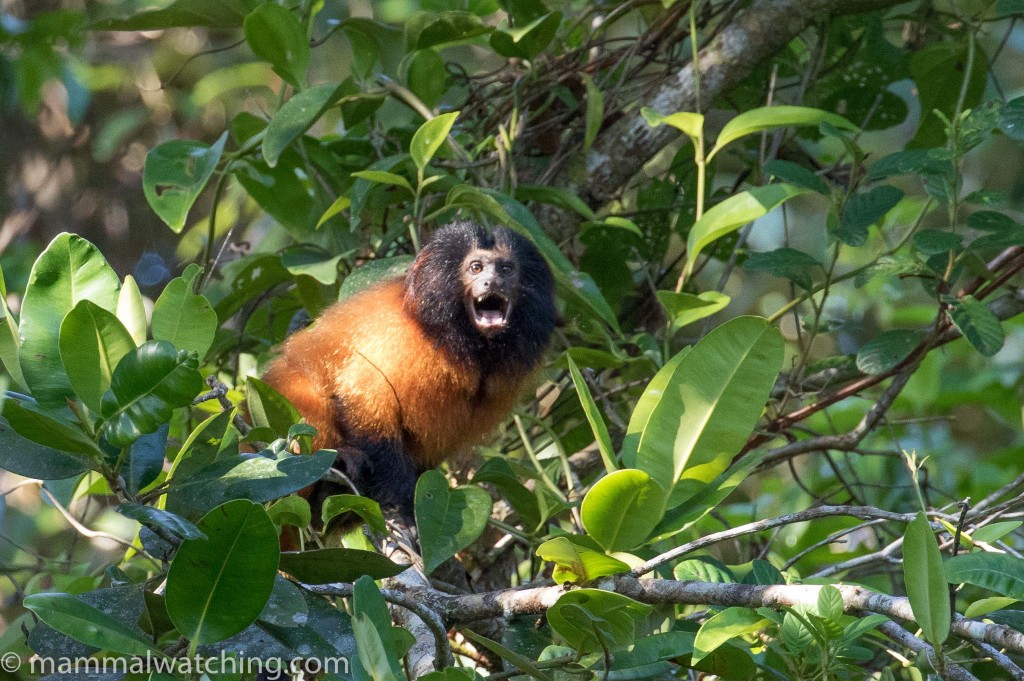
Black-faced Lion Tamarin, Leontopithecus caissara
In February 2017 I was sitting in a Brooklyn bar having a beer with my buddy Luqman and meeting for the first time his friend Gilbert who was visiting from Brazil. Before we’d finished the first beer we discovered that Gilbert had looked at mammalwatching.com. This was kind of exciting for me because although he is interested in just about everything he could never be described as a mammal watcher.
By the third beer we were talking mammals, and I mentioned that the Superagui Lion Tamarin was one of my most wanted Brazilian species. Big coincidence. Gilbert, it turns out, might be more familiar with Superagui Island than anyone outside of the 108 people who live there: he had, some twenty years ago, spent 5 years working with the islanders to build a school and help the community. By the fifth beer we were best friends forever and committing to visit the island together. I don’t remember much about the evening after that, but my hangover the next morning wasn’t enough to take the shine off of the mammalian anticipation.
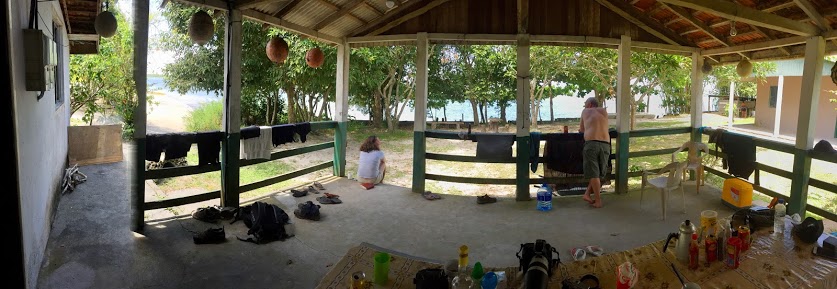
Relaxing between mammals…. Photo by Luqman
Exactly one year later a group of us were converging on Brazil for a week of fun and fur. I would describe this as a friends trip with mammals, rather than a mammal trip with friends. The friends were comprised of: Sion – a childhood friend who wanted to escape February in the UK; Luqman – who is polite enough to listen to my mammal stories every time we go to the pub and wanted to escape February in NYC; Gilbert and Cadu – who are probably more interested in eating mammals rather than seeing them and had no need to escape Brazil in February. And my partner Amber. Amber suggested that maybe we might slow down a little on this trip and even “relax”. Something apparently other people do when not looking for mammals. So I tried – through gritted teeth – to avoid what some might describe as mammal boot camp.
The trip to Superagui Island was the centrepiece of the week away, but I added side trips for Black Lion Tamarins and Buffy-tufted Marmosets to the itinerary as optional extras.
Black Lion Tamarins: Teodoro Sampaio, Sao Paulo
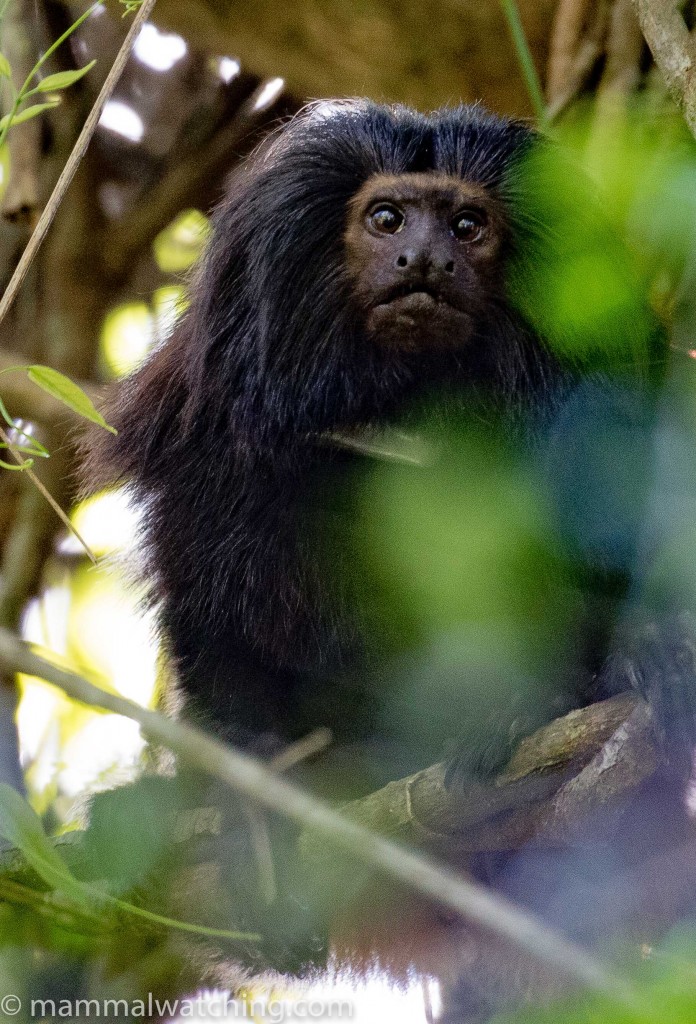
Black Lion Tamarin, Leontopithecus chrysopygus
The four species of Lion Tamarins are spectacular primates. I’d seen Golden Lion Tamarins in 2009 and Golden-headed Lion Tamarins in 2013 and I wanted to complete the set. So Amber and I started our trip following in Richard Webb’s footsteps to Teodoro Sampaio, about half way between Sao Paulo and Campo Grande.
We flew into Sao Paulo’s Guarulhos Airport (GRU) on Friday morning. Ten years ago Brazilian airports were unfailingly chaotic. How things have change. GRU might be the quickest, friendliest and most efficient airport I have ever encountered. There was no queue at immigration and after 2 minutes with a smiling, friendly and – let’s be honest – beautiful immigration officer we were at the baggage carousel. Our bags had beaten us there. Eat your hearts out Kennedy, Heathrow and Charles de Gaulle airports.
From there we Ubered across Sao Paulo to Campinas Airport (Uber is definitely the way to go in Brazil) and took an evening flight to Presidente Prudente, the closest airport to Teodoro Sampaio, a small town in the heart of Black Lion Tamarin country.
Regina Ribeiro, who has to be Brazil’s best nature guide, had been as helpful as always and hooked me up with Gabriela Resende who runs the Black Lion Tamarin project. Gabi wasn’t in town, but she arranged for Leonardo Silva, one of the researchers, to take us to the project on Saturday morning. Leo also arranged for a local taxi to ferry us the 90 minutes between the airport and the Onix Hotel in Teodoro Sampaio (probably cheaper than hiring a car and I couldn’t figure out if there were any hire car offices open in any case).
Teodoro Sampaio is a little larger than a one-horse town, but not by much: one horse and a small donkey maybe. The Onix hotel was clean and super friendly, but there isn’t much to do in town when you aren’t looking for monkeys or eating at the gas station across the road. When we asked if they had a swimming pool the manager just laughed. When we asked if there was a pool in town, he laughed again.
There are a few Black Lion Tamarins in both Morro Diablo National Park and some of the forest fragments nearby. Gabriela’s project usually have animals radio-collared in one or more areas. But this wasn’t the case two weeks before we arrived, after a monkey lost its collar, and so I had resigned myself to disappointment: the monkeys are extremely hard to find without some technological help. Fortunately, the researchers were able to collar an animal just days before we arrived in one of the forest fragments.
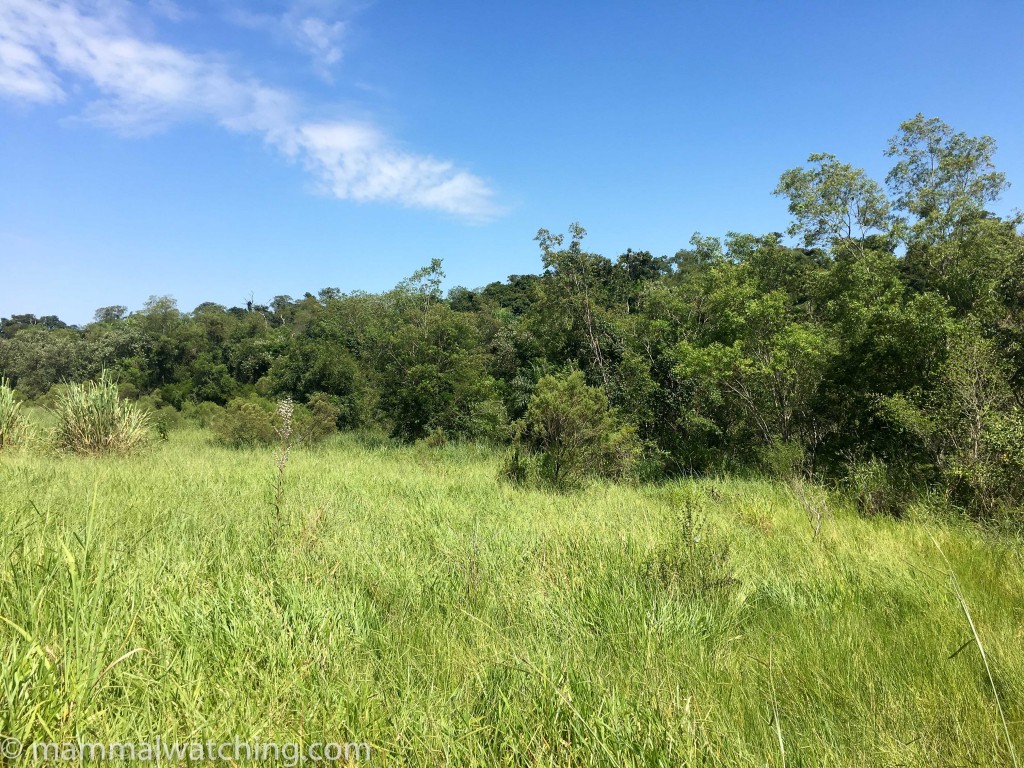
Forest fragment
Leo and his field assistants picked us up at 5 a.m. and we drove to a rainforest patch about 45 minutes out of town. We arrived well before dawn on the edge of a cane field and were each thrust a pair of gaiters each.
“Why?” asked Amber. “Snakes” said Leo.
We waded through the long grass and the dark towards the forest. I don’t usually give much thought to snakes, but they may have crossed my mind that morning.
A thirty minute – and snakeless walk – through the forest got us to the base of a tree in which – according to the radio signals – the Lion Tamarins were sleeping. This group had a week-old baby Leo explained, and so were particularly cautious, leaving the roost much later than would normally be the case. We sat on the ground and waited. For three hours. At which point some high-pitched whistles signalled the monkeys were, if not on the move, at least up and about.
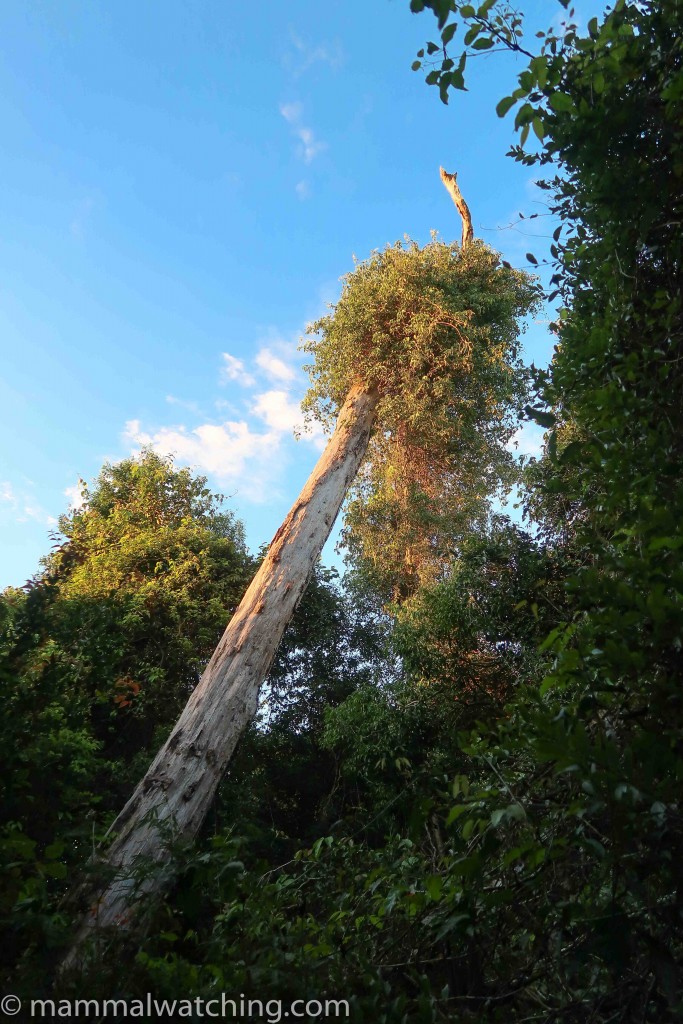
Lion Tamarin roost tree
It took another half an hour for us to see an animal. But with the help of Leo and his technicians we eventually got good looks at at least three Black Lion Tamarins, peeping through the leaves at us. Photography was a challenge, but the experience was a lot better than Richard Webb who was really unlucky here I think. But these are a particularly shy Lion Tamarin to observe. A fitting species for the 1700th mammal on my life list.
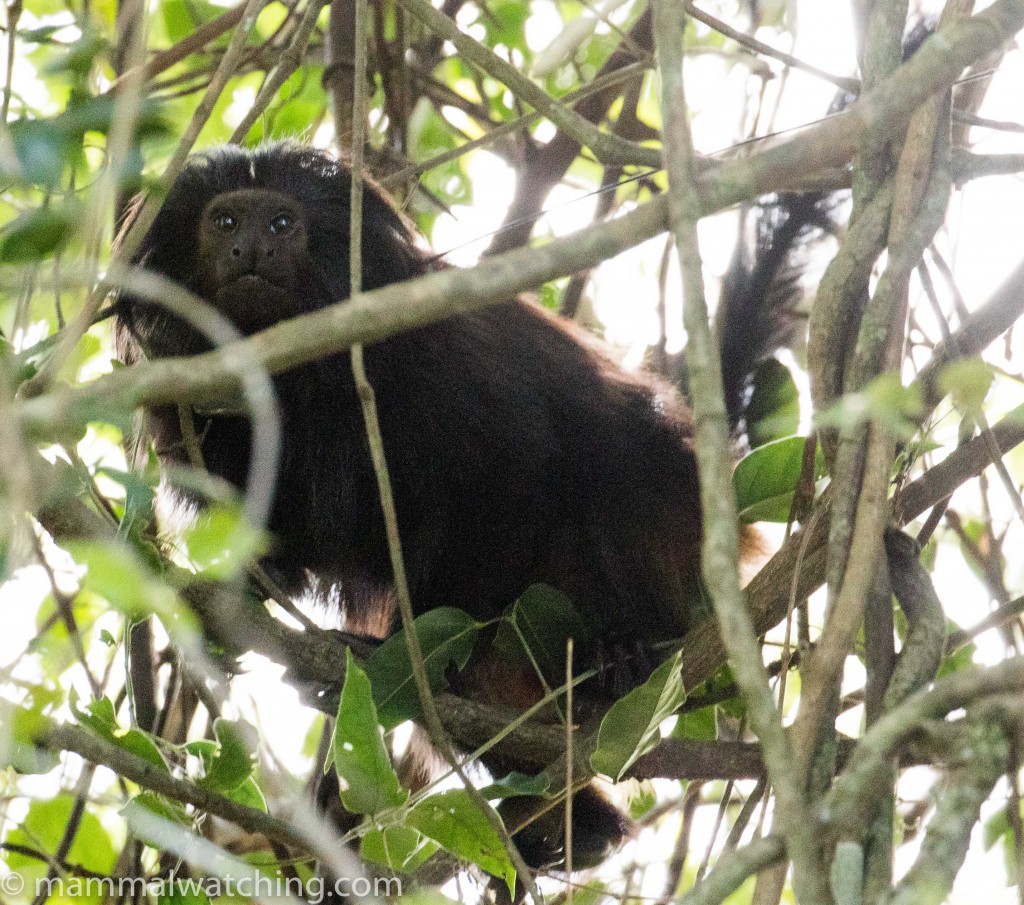
Black Lion Tamarin, Leontopithecus chrysopygus
After forty-five minutes with the animals we let them be, in part concerned that our presence might be preventing them from feeding. Amber and I spent most of the rest of the day at a “catch your own fish” restaurant in town: at least that is what we think it was … a gaggle of happy people pulled fat Tilapia excitedly out of the swimming pool next to the outside dining area. And then we ate dinner at the gas station. It is that kind of a town.
At 9 a.m. the next morning our friendly taxi driver took us back to Presidente Prudente and our flight back to Campinas Airport in Sao Paulo.
Buffy-tufted Marmosets: Nazare Paulista, Sao Paulo
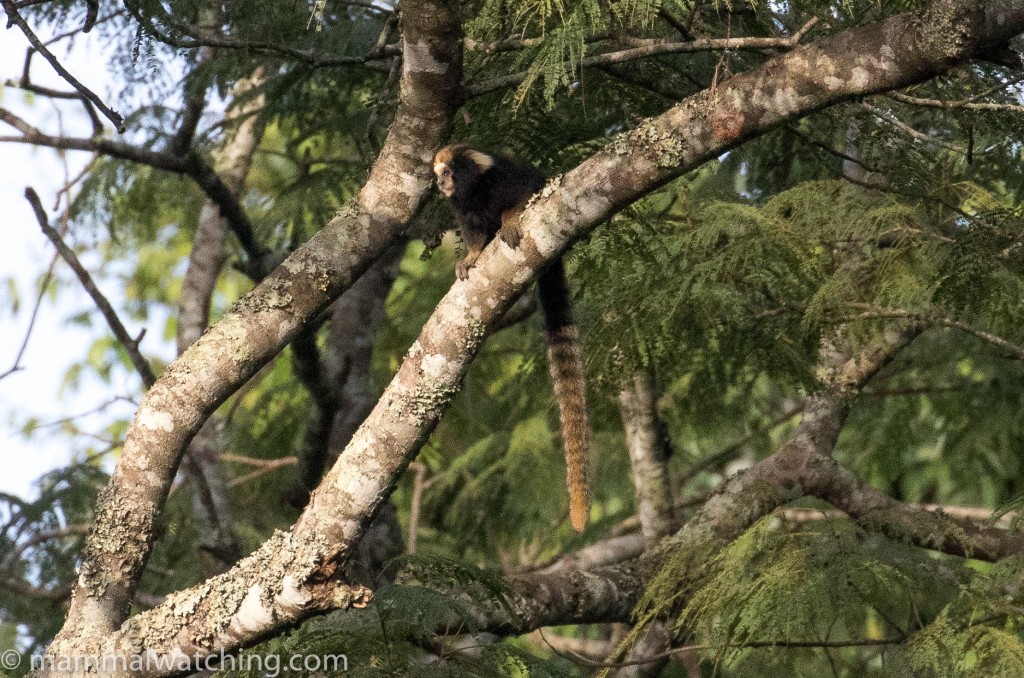
Buffy-tufted Marmoset, Callithrix aurita
Our next stop was Nazare Paulista, a town close to Sao Paulo. I’d visited a site here in 2013 to look for Buffy-tufted Marmosets but a delayed flight meant I missed them.
We hired a car at Campinas Airport (again a much easier experience than the last – painfully frustrating – time I’d hired a car in Brazil 5 years earlier). It was an hour to the really lovely Ladi’vtta Spa Hotel in Atibaia. My buddy Sion met us there.
Early the next morning Sion and I set off in search of marmosets. After managing to break out of (or maybe just break) the hotel’s security gates it took just 20 minutes to drive to the marmoset site (it is more or less here but the directions in my 2013 trip report are still accurate).
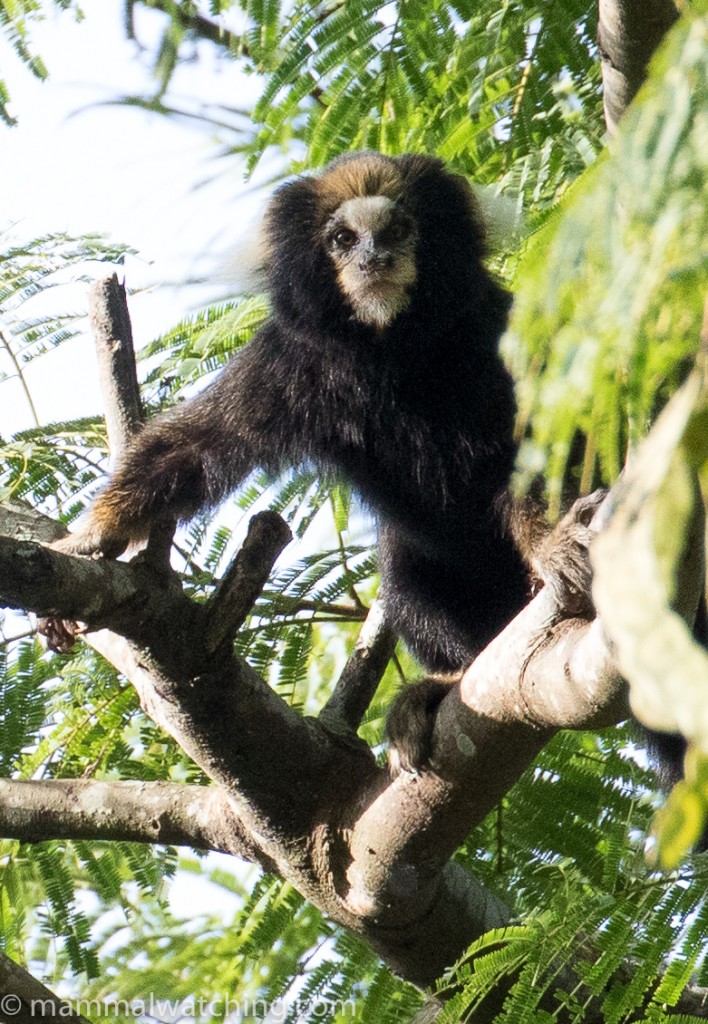
Buffy-tufted Marmoset, Callithrix aurita
We arrived about 7 a.m. and parked the car at the entrance to the I.P.E. (Instituto de Pesquisas Ecológicas) research camp. After wandering the grounds for 10 minutes and seeing only a Guianan Squirrel I had a “chat” with a guy cutting the grass (I think chat might be exaggerating the level of verbal communication between us: I showed him a picture of a marmoset on my phone and pointed randomly, while he indicated – I think – that I might wander further down the road in search of monkeys). We did. Five minutes later we heard Titi Monkeys calling, followed by Buffy-tufted Marmosets. Sion spotted a group of animals.
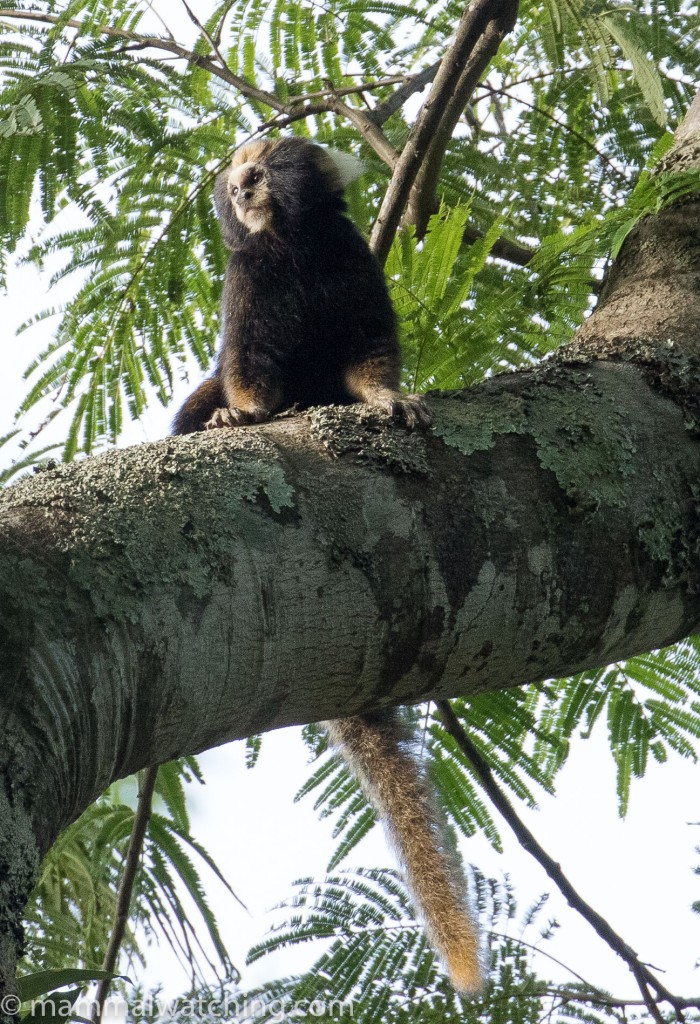
Buffy-tufted Marmoset, Callithrix aurita
They came very close to the road – perhaps in response to the calls I was playing on my phone – and we had excellent views.
At least two groups of Black-fronted Titis were also calling near the road but we couldn’t spot them. I’d seen this species before so, after 20 minutes of searching, we decided to retreat to the delights of breakfast and the pool at the Ladi’vtta Hotel.
After lunch we drove through a titanic thunderstorm to Guarulhos Airport for the short flight to Curitiba, where we met the rest of the Superagui Tamarin expedition.
Black-faced Lion Tamarins: Superagui Island, Parana
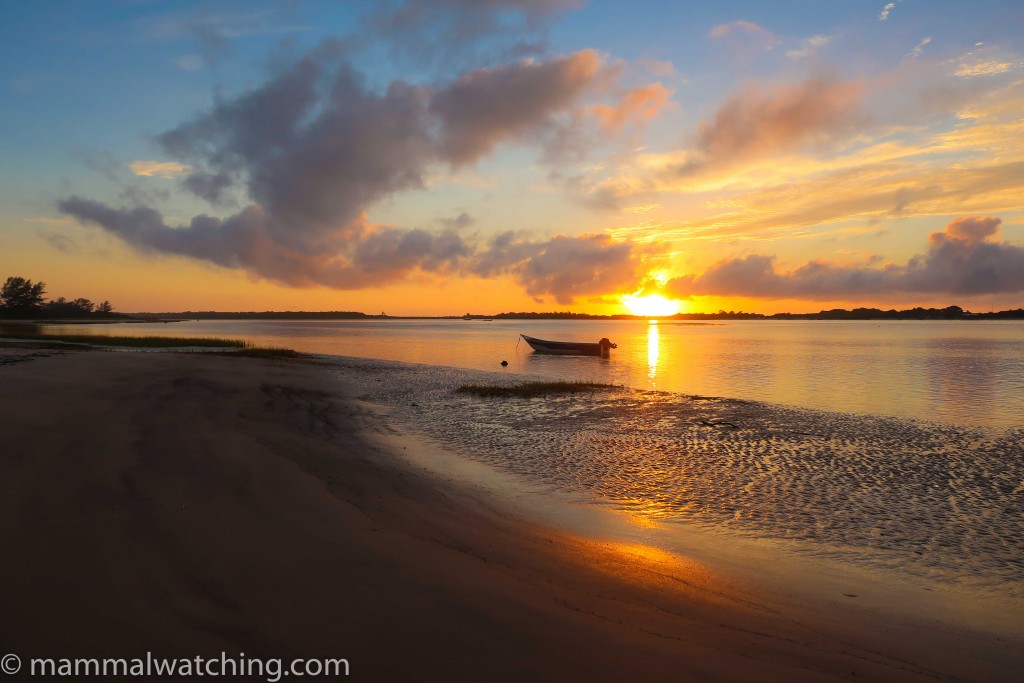
Ilha do Superagui
Ilha do Superagui is wonderful and wonderfully unknown. I found it hard to understand exactly where we were going, or how we were going to get there, until we arrived. There was no information online, the maps were vague and Gilbert was too excited for me to completely understand him.
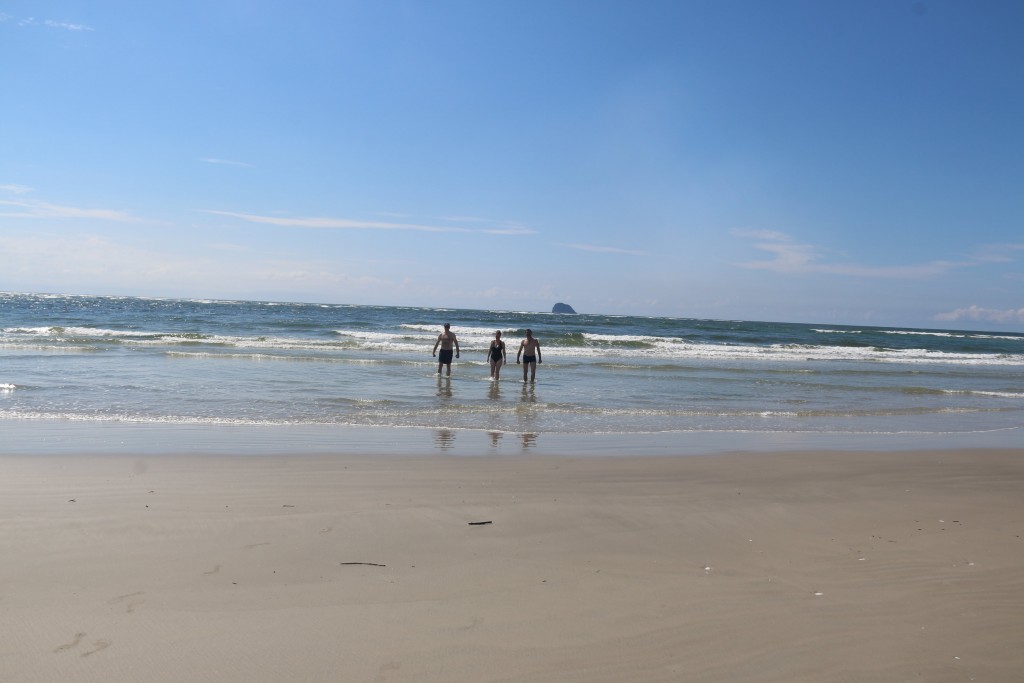
Superagui beach. Photo by Cadu
In fact we were based at the tiny community (30 or so families) of Barra da Ararapira, on the oceanic side of the island, about half way up the coast. We were just opposite the tip of the long spit of the mainland that drops down from Sao Paulo state and shelters the northern coast of the island.

Barra da Ararapira panorama (photo by Luqman)
Superagui Practicalities
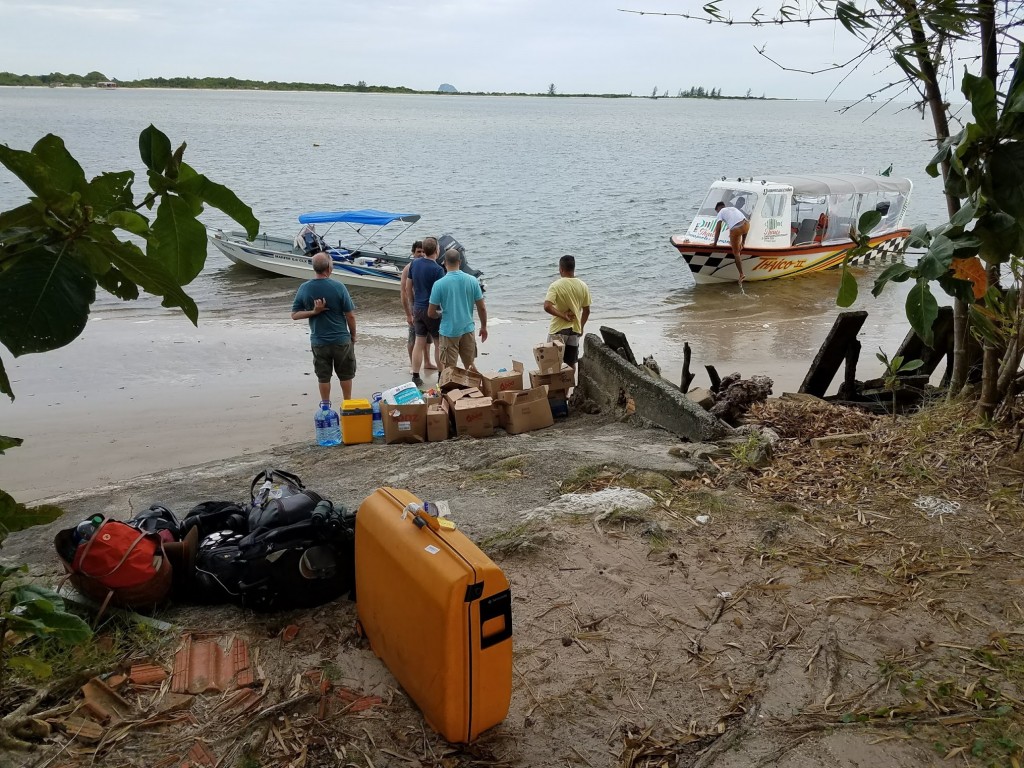
Island arrival (photo by Amber)
There is no public transport to the island and to get there from Paranagua requires chartering your own boat. When the seas are calm it is quickest to head up the coast out of Parana and reach the island over a shallow sand bar. In less than perfect conditions you have to travel up the Parana Estuary and navigate around the top of the island and back down the lagoon (there is a channel even if it isn’t apparent on google maps). We hired a fast boat, capable of taking 15 people (or 6 plus 3 tonnes of beer). We did the journey in 3.5 hours on the way in (taking the estuary route) and 2 hours on the way back along the coast.
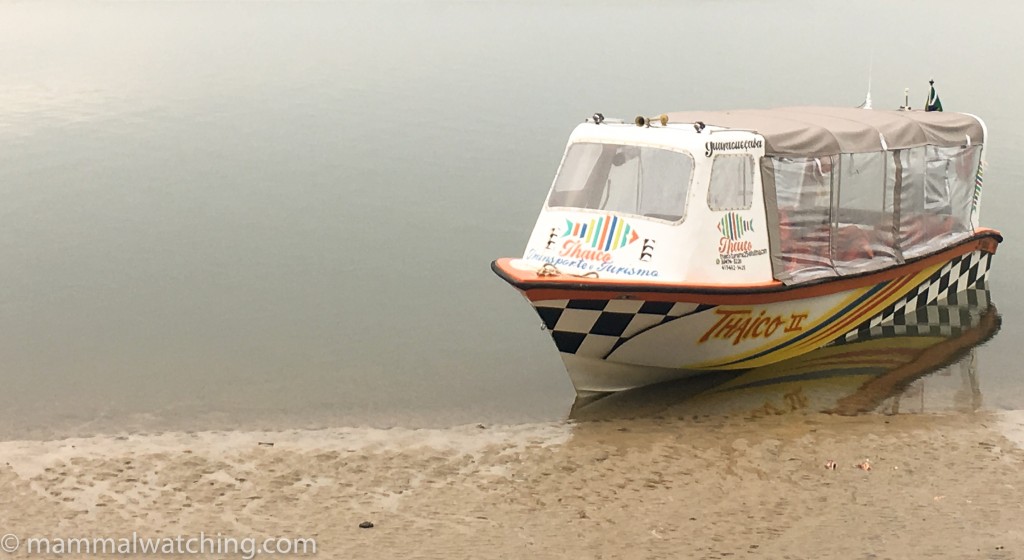
Transport
We took all our own supplies. The villagers sold us fish, shrimp and booze (a local variation of cachaca called cataia) but we needed to bring everything else.

Groceries
We bought a ridiculous amount of food in Parangua. But then again Gilbert is a ridiculously good cook. None of the meat and booze went to waste (though the salad did – told you!). We each returned 10 lbs heavier.
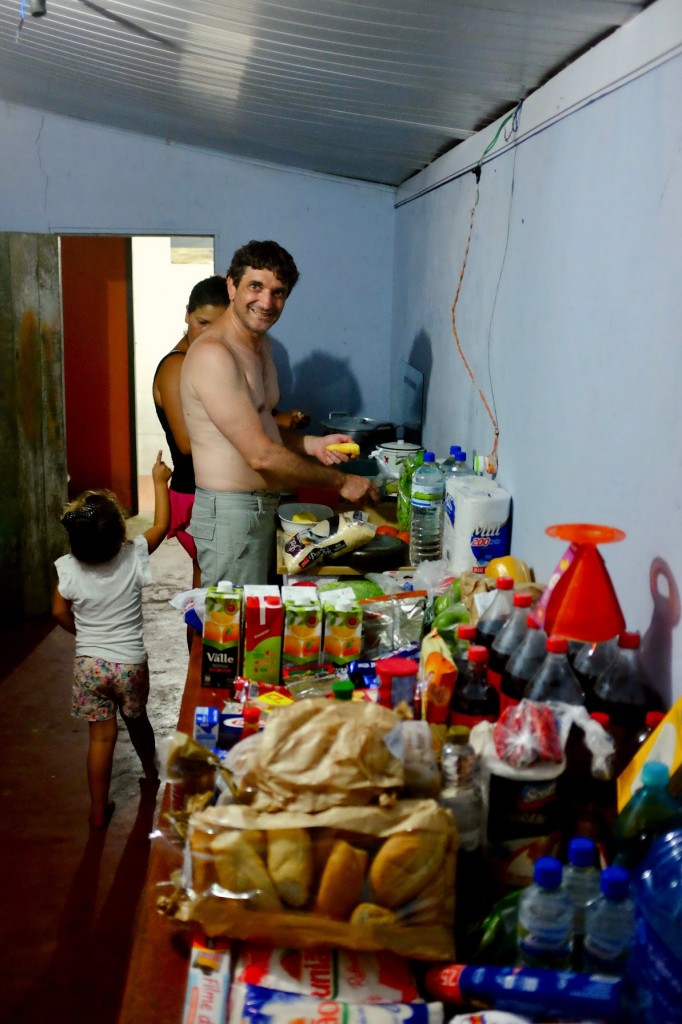
Gilbert cooking up a storm (photo by Luqman)
We stayed in a “guest house”: an empty house, with 4 bedrooms, 2 bathrooms, and a stove. There was generator electricity in the evenings, and gas-powered hot water for the shower. Gilbert also arranged for one of the locals, Shirley, to help out with the cooking. I would like Shirley to come on every trip from now on.
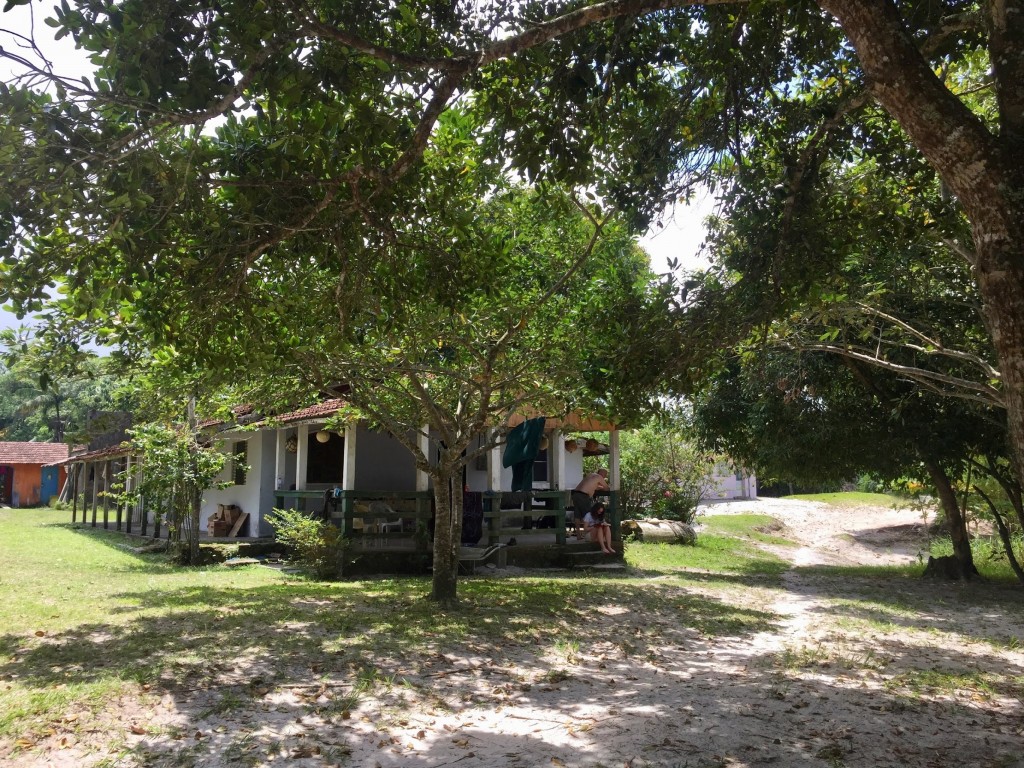
Superagui Guest House (photo by Luqman)
There was no cell service but we could use the neighbours’ wifi if we really wanted it. I did as I was agonising over dolphin pictures and trying to prove to myself I had seen a Franciscana, but no one else bothered. There’s a pay phone too.
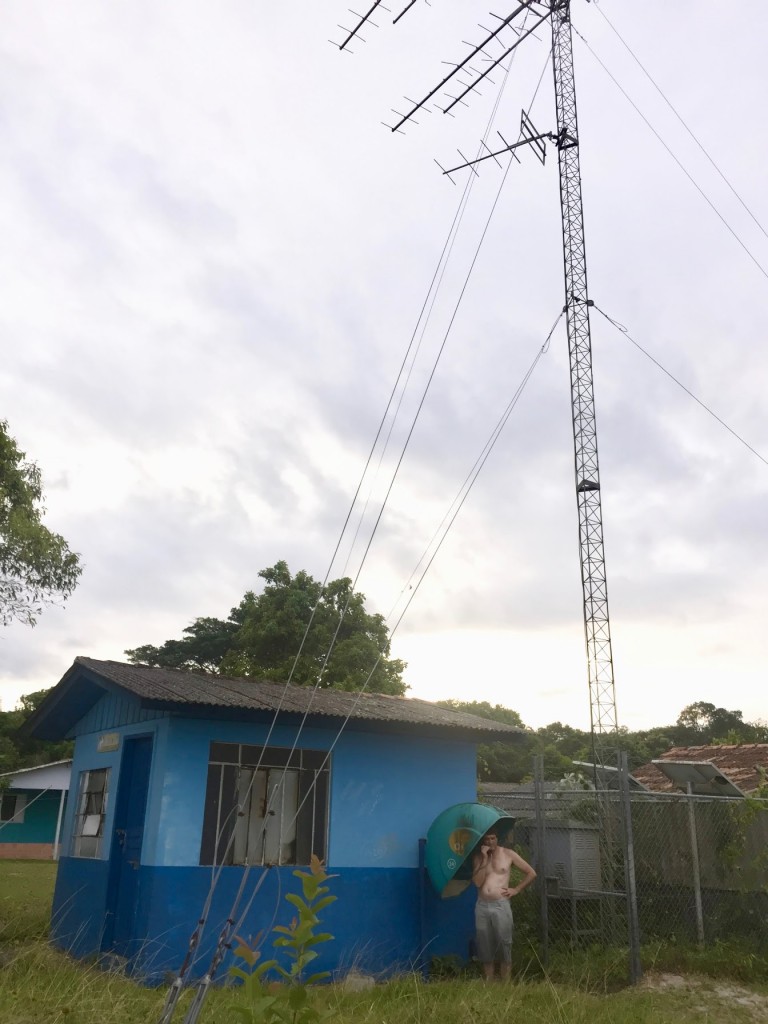
Gilbert makes a call
Superagui Lion Tamarins
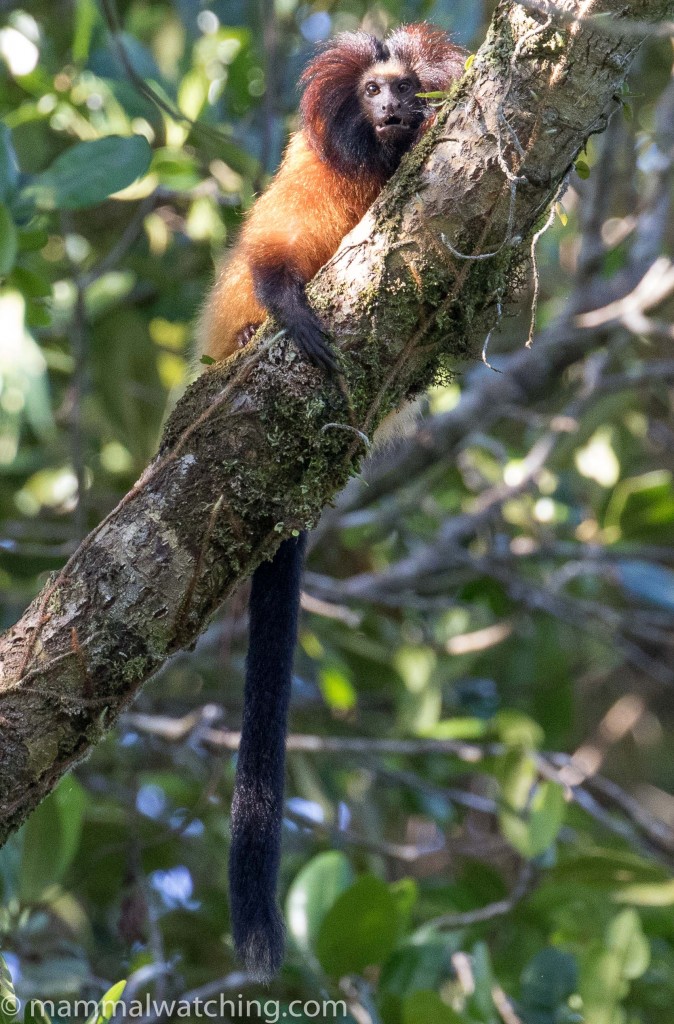
Black-faced Lion Tamarin, Leontopithecus caissara
Of course it is all very well feasting, drinking and napping on an island paradise, but sooner or later you are going to want to look for the tamarins.
Unfortunately, none of the locals had much of a plan on how to find them when we got there. There are likely fewer than 200 animals on the island, with another 200 or so across two populations on the mainland. And the island is 40km long. A group of tamarins had been seen in the village a week before we arrived, but this seemed to be something of a rarity because all the islanders we met remarked on it. There aren’t really any trails into the forest either. Tamarin researchers had cut trails a few years earlier but they had grown over after the project finished. It wasn’t looking great.
When we arrived, we met Marcio, one of the few locals who wasn’t planning to fish the next day. He agreed to lead us into the forest the next morning. And at 7 a.m. all six of us were following him.
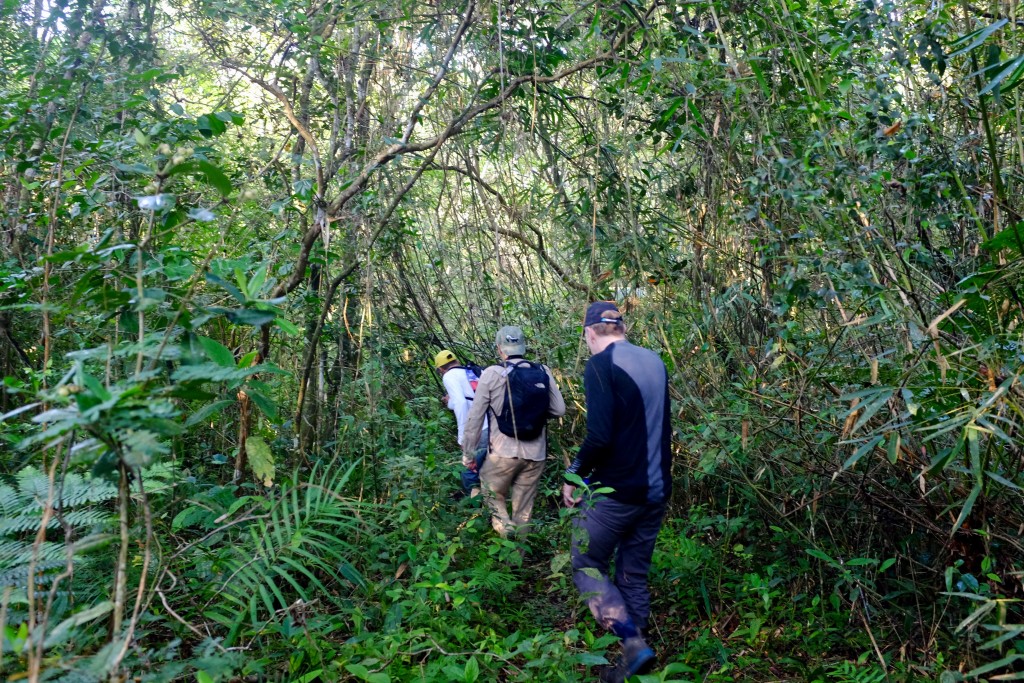
Superagui hike (photo by Luqman)
The hike was hard going, what with the mosquitos, thorns and trying not to sink knee deep in mud. See Luqman’s short video here from. After five hours we hadn’t gotten close to any monkeys. I thought at one point we heard a group but, after much debate and call playback, decided we were listening to birds.
By midday we were back at the guest house. I think it is safe to say that none of us had really enjoyed the morning, while one or two might be more forthright in their opinion. I had concluded that we had preciouslittle chance of seeing monkeys while bashing through the bush.
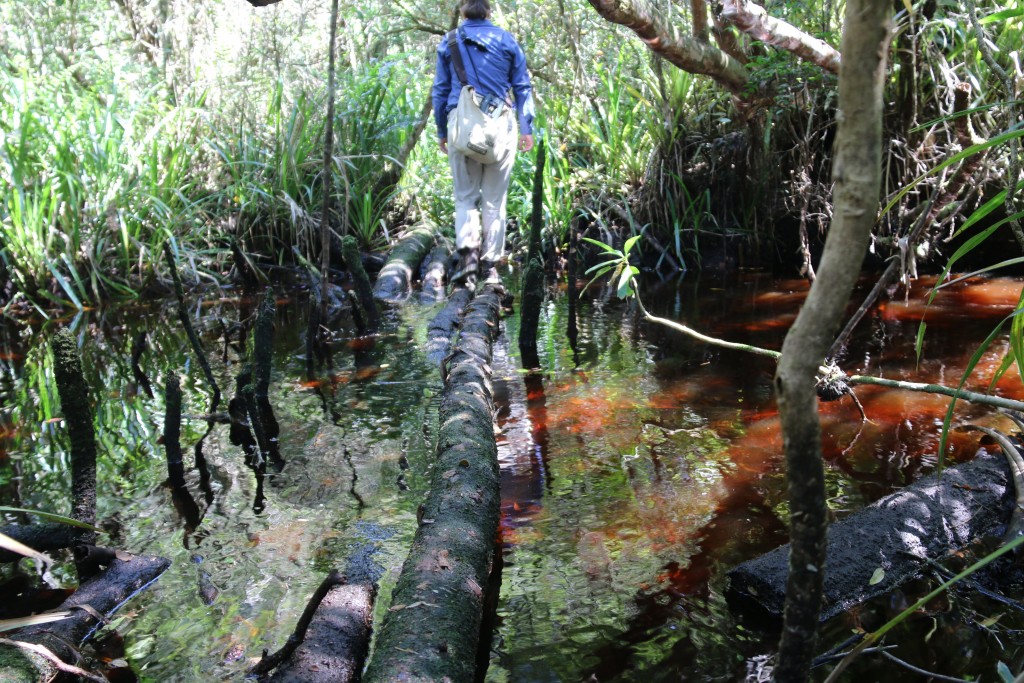
Amber crosses a swamp (photo by Luqman)
The next morning Luqman and I went out again with Marcio (the others opted for the beach). Thankfully Marcio had been talking to some of his neighbours and had been advised that we might have better luck along the trail north out of the village and along the beach. This is a decent trail: even if we didn’t find the monkeys, it was going to be a lot more pleasant.
Just 20 minutes out of the village we heard some distinctive high-pitched whistles and Marcio walked a few feet into the forest. Lion Tamarins! He urged us forward, spotting an animal or two before we did, at which point the family disappeared deep into the jungle. Damn.
I thought we had missed our chance but Marcio led us back down the coast for a couple of minutes and then into the forest in the hope we might intercept the animals. I wasn’t convinced but 15 minutes later we heard a group calling. We sat down and I started playing Lion Tamarin calls and the monkeys came closer. Another five minutes later we had our first glimpse. A genuine, wild, Black-faced Lion Tamarin!
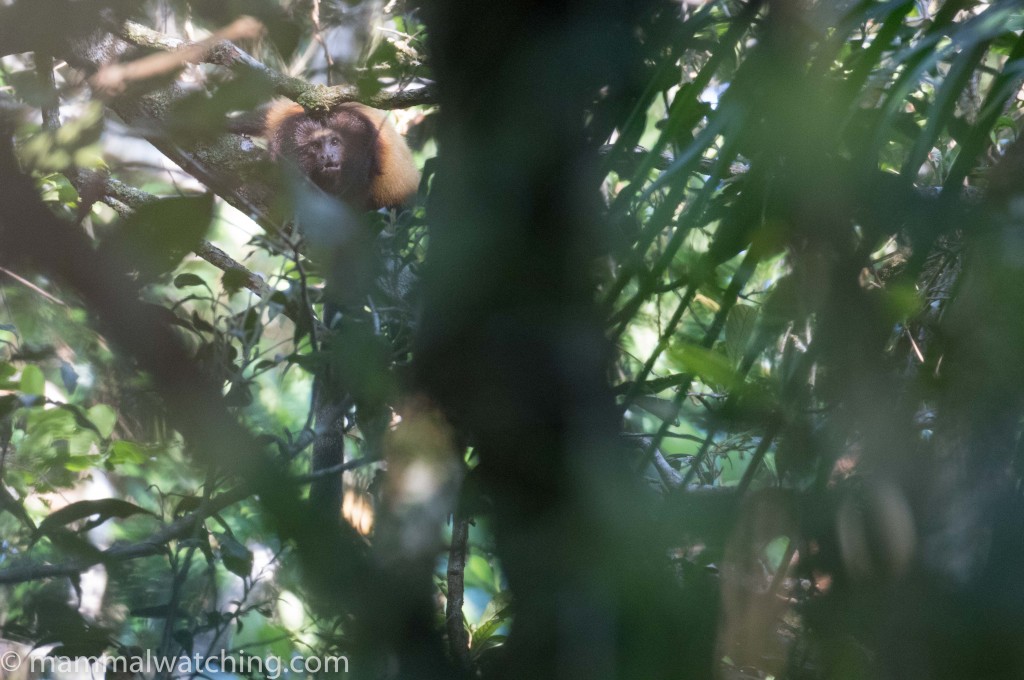
Black-faced Lion Tamarin, Leontopithecus caissara
We waited and the animals got closer.
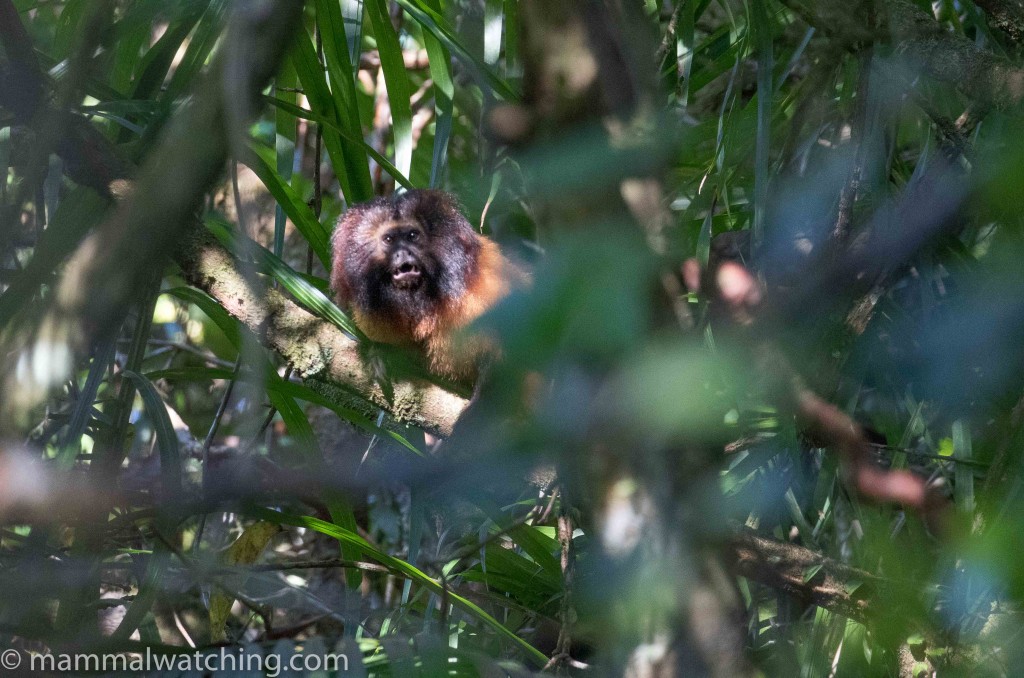
Black-faced Lion Tamarin, Leontopithecus caissara
And closer. And then they started to relax.
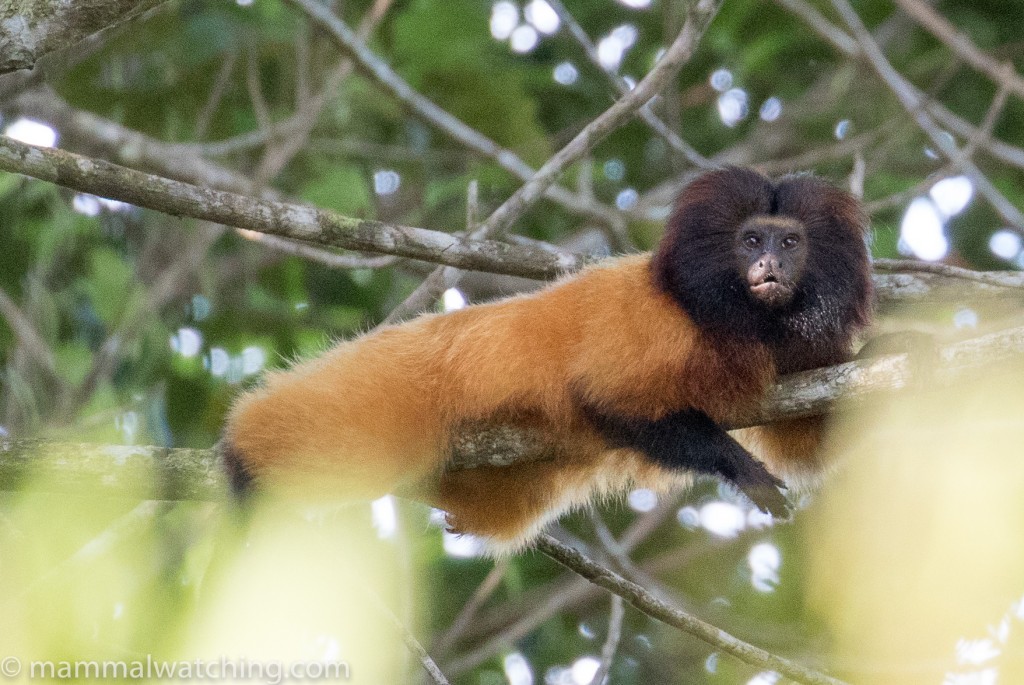
Black-faced Lion Tamarin, Leontopithecus caissara
They were making a real racket (the sound from Luqman’s film makes useful call playback material). Luqman, Marcio and I spent 45 minutes with a group of perhaps 10 animals right in front of us. Absolutely magical and beyond doubt my best ever Lion Tamarin sighting.
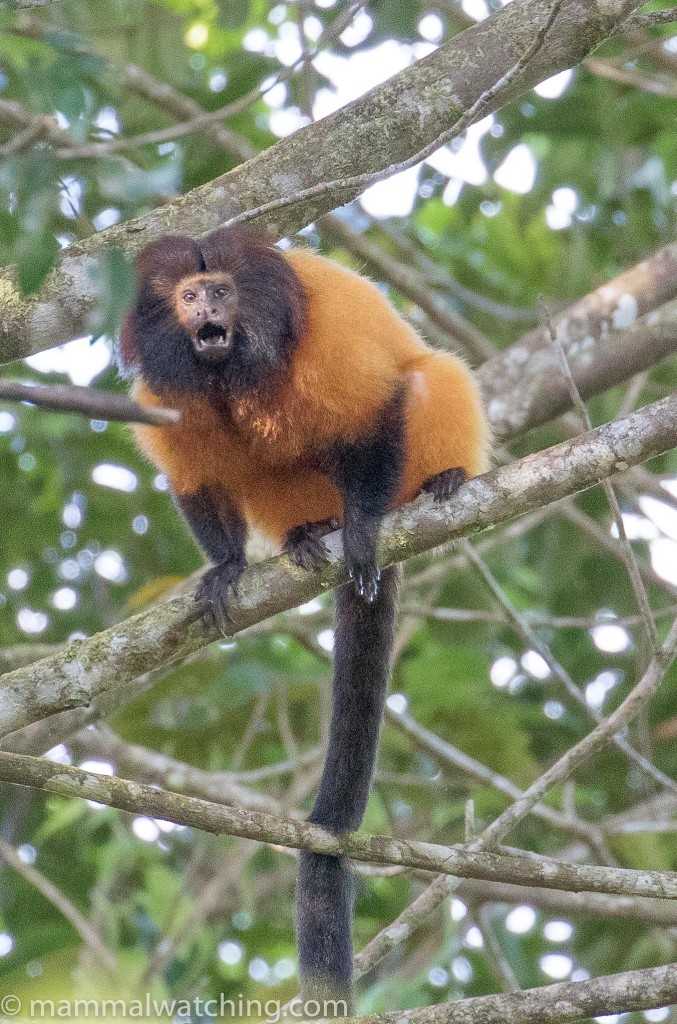
Black-faced Lion Tamarin, Leontopithecus caissara
Eventually the monkeys grew bored and moved off into the forest. Luqman, Marcio and I swaggered back to the village, our grins visible from space. And Luqman a firm convert to the mammalwatching camp.
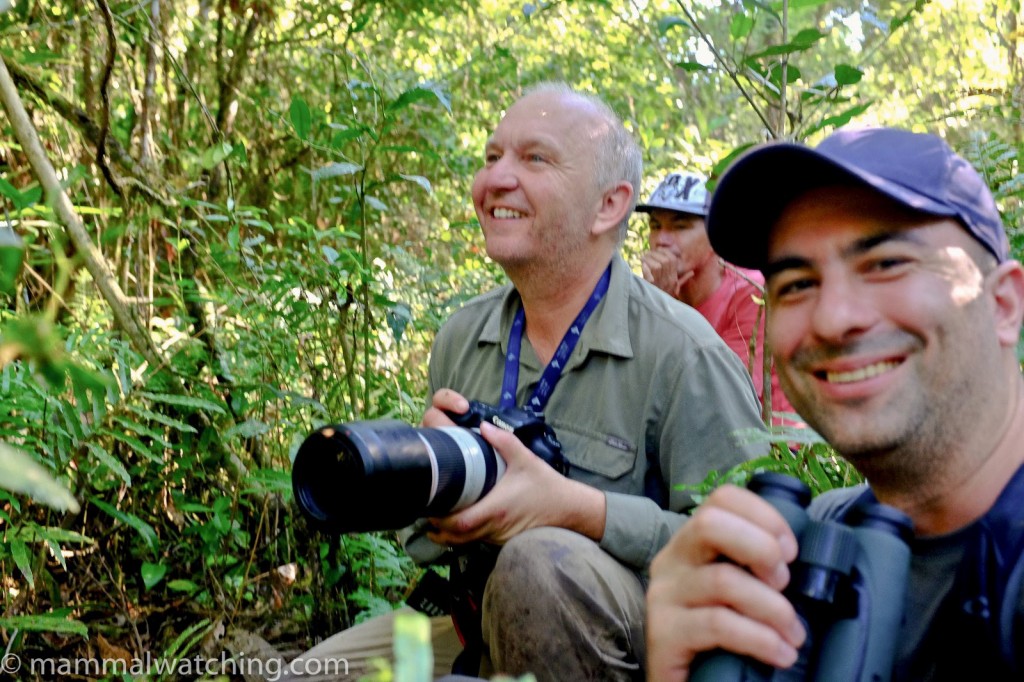
Happy mammal watchers (selfie by Luqman)
Many thanks to Marcio our guide for intercepting them so well.
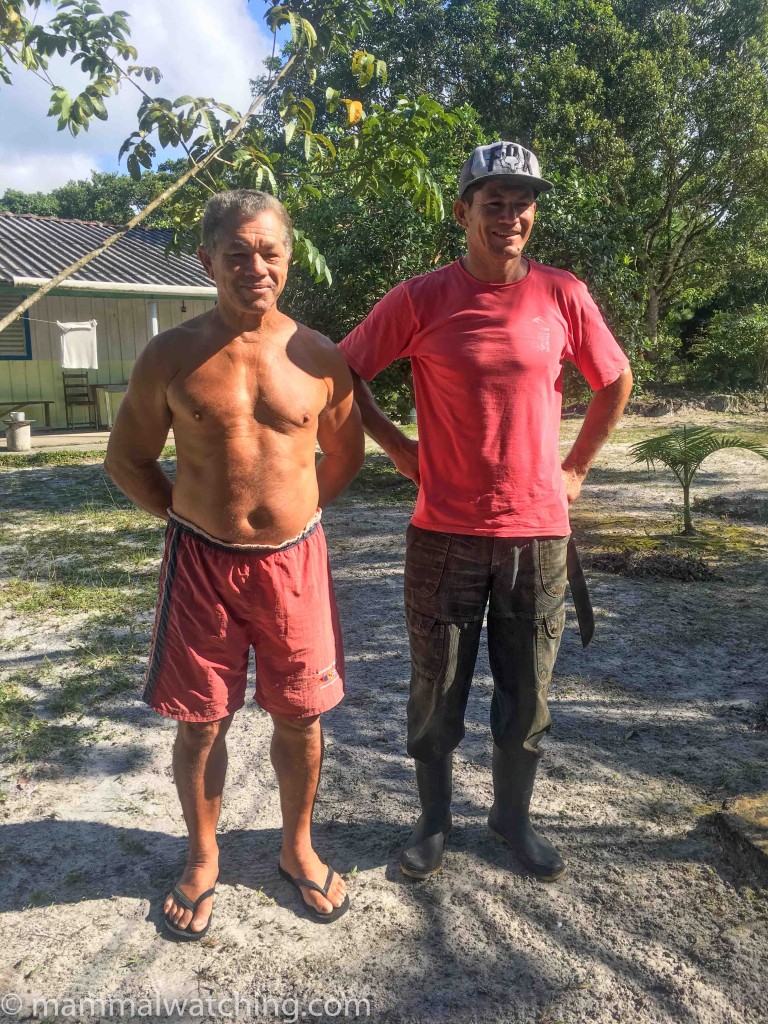
Marcio (right) and his father, Rubens (left). Rubens was involved in one of the earliest studies of the Lion Tamarins on Superagui.
Other Mammals
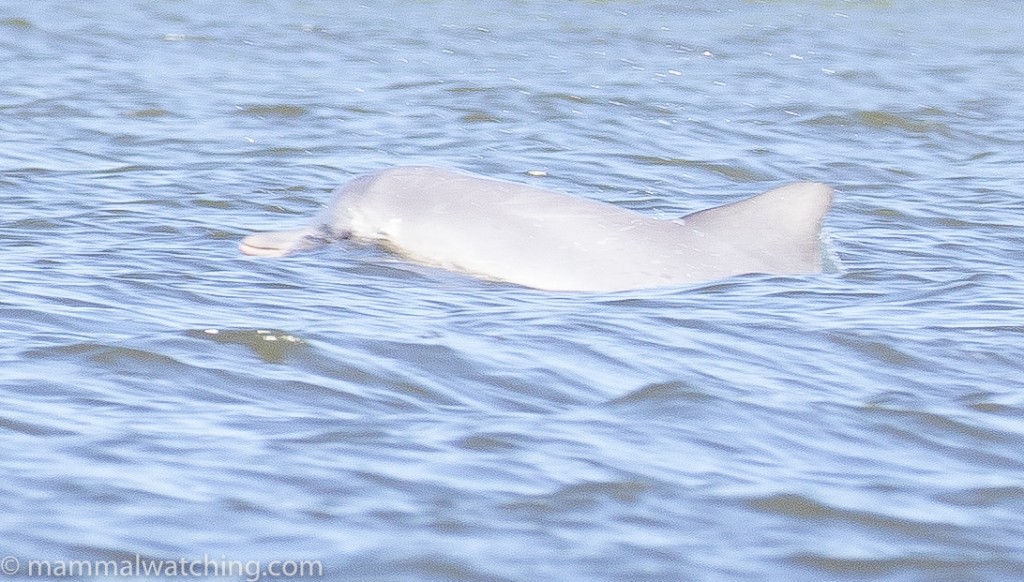
Guiana Dolphin, Sotalia guianensis
Though there are doubtless other mammals on Superagui Island (including Jaguars from time to time) we didn’t make much of an effort to look for them, and none of the villagers suggested other mammals were particularly visible.
On the boat trip in we saw many dolphins. All of those I managed to photograph proved to be Guianan Dolphins, Sotalia guianensis, despite my best efforts to turn them into Franciscanas (some discussion on the forum is here).
But – 10 years ago at least – there were also Franciscanas in these waters. I see no reason to doubt that they aren’t there still and the fisherman seemed to think that there are both short and long-nosed dolphins around (even if they announced that one on my photos was of the “long-nosed” flavour when in fact it was a Guianan Dolphin).
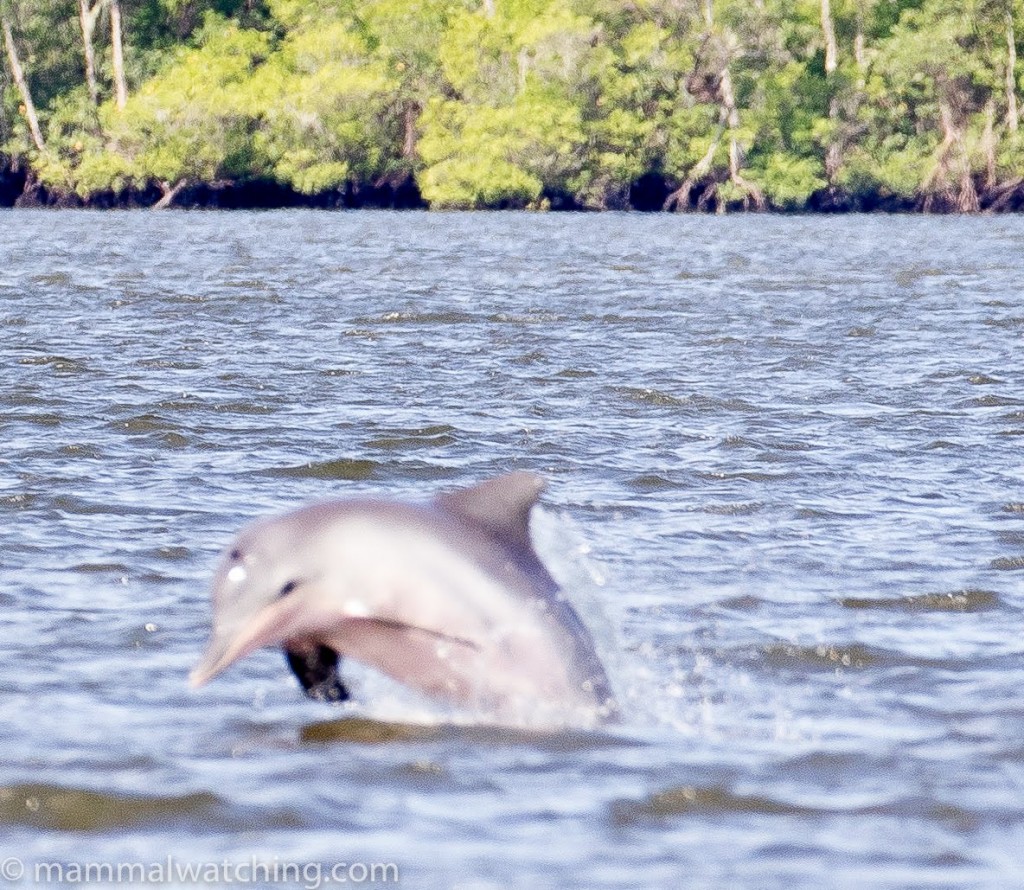
Guiana Dolphin, Sotalia guianensis
I took a short walk on our last night after dusk, as I was keen to check for bats in an abandoned house at the edge of the village. The only bat inside flew as soon as I saw it: at first glance it looked like one of the Long-tongued Bats (Glossophaga species). The only other mammal that night was a White-eared Opossum deep in a bush.
Back in Curitaba for the weekend we made no effort to look for wildlife. In fact the only mammal sighting of note was having brunch next to random members of the Foo Fighters and Queens of the Stone Age at Curitiba’s Nomaa Hotel. Cadu’s excitement was second only to mine after the tamarins.
Closing Thoughts
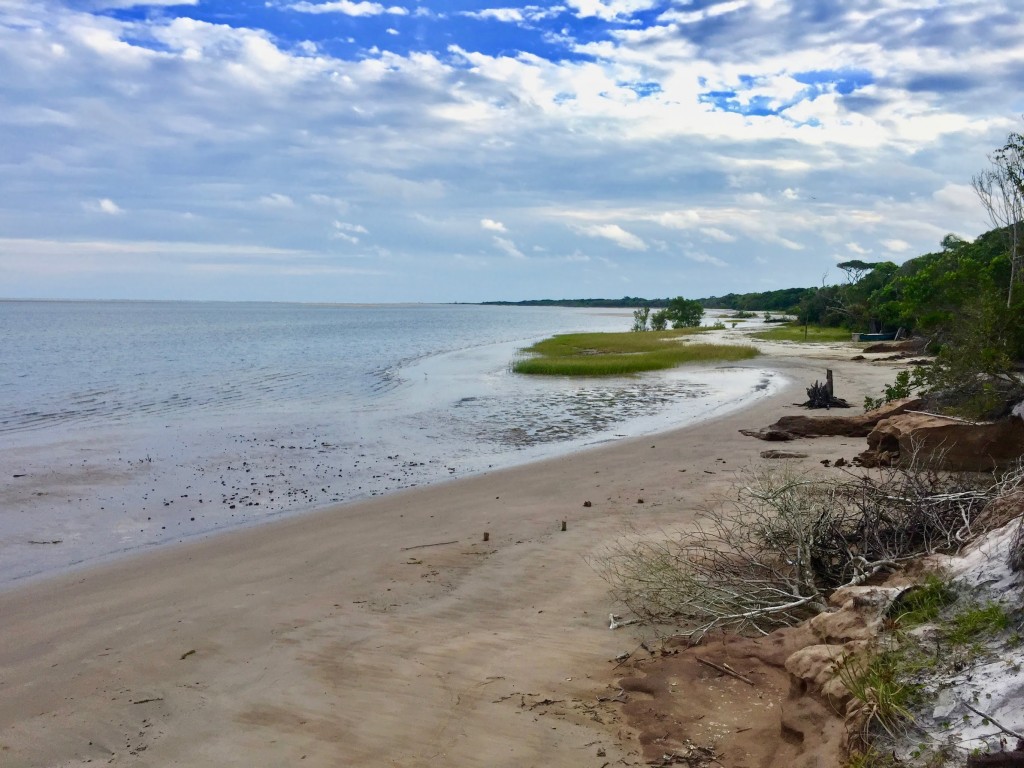
Photo by Luqman
In a world that is increasingly small it is hard to think of anywhere quite like Superagui: a bona fide island paradise, close to major cities and yet virtually untouched by tourism. Perhaps, more than anything, we were struck by how happy the community there seem. They appear to want for very little, and get to spend their days fishing, much as they have done for the past few hundred years, albeit now with better health care, a school and wifi. I know this sort of stuff might sound naively idealistic but we heard that several people in the village had left the community in recent years to try life outside but had returned.
In fact, it is such a special place that I was cautious even to share this post. So we checked first to see if the community were in favour of more mammal watchers visiting. They seemed to like the idea. I am not sure if that’s because we made a good impression, or because we drank enough Cataia to fund the school for the next year. But in either case visit while you can because tourism is surely coming one day soon. Write me an email if you want more details on how to arrange a visit there.
A huge thanks to all on the island for looking after us so well, to Marcio our guide, Shirley our housekeeper, and to all my travel companions who, despite the mud,bugs and risk of snake bite are still talking to me. Most of all a very special obrigado to Glbert for organising the adventure and keeping us so well fed.
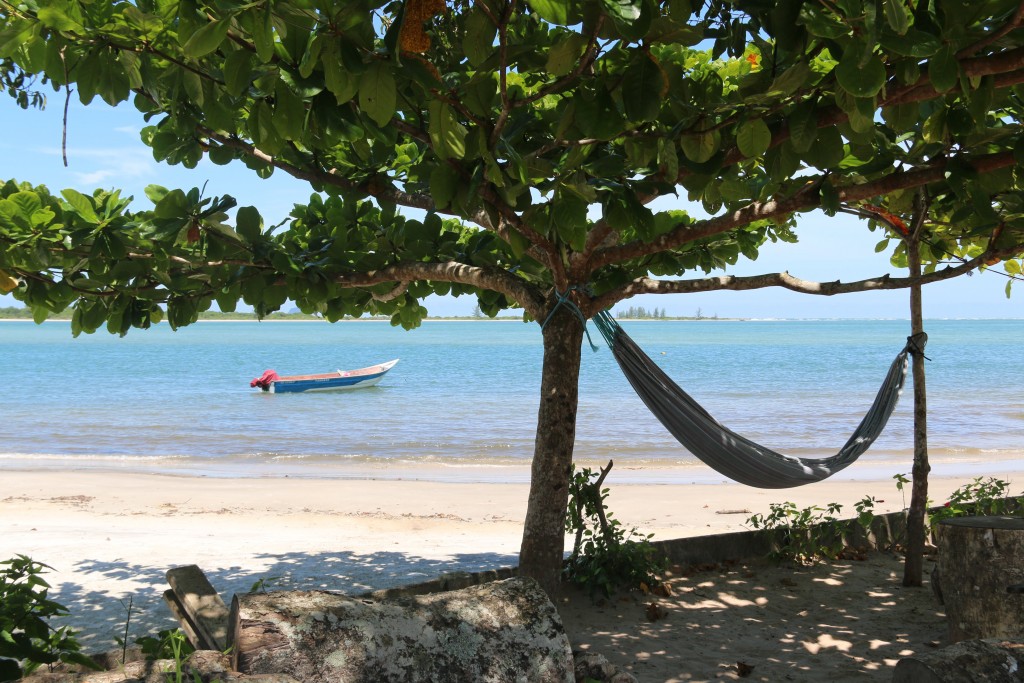
Photo by Cadu
3 Comments
Leave a Reply
You must be logged in to post a comment.


Jim Tassano
Well done. Thanks for sharing!